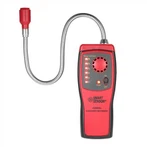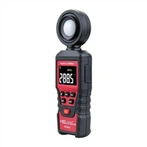Detailed explanation of the structure principle and daily maintenance of the ph meter
To measure the pH value of the solution, the industrial pH meter is composed of the principle of potentiometric method, which is composed of the sending part composed of pH electrodes and the detection part composed of electronic components. The sending part consists of a reference pH electrode and a working pH electrode. When the measured solution flows through the sending part, the pH electrode and the measured solution form a chemical primary battery, and a potential is generated between the two pH electrodes, and the magnitude of the potential has a logarithmic function relationship with the pH value of the measured solution. So the sending part is a converter that converts the pH value of the measured solution into an electrical signal.
The principle of the pH meter
By measuring the potential difference measured in the solution of the working battery composed of the electrode and the reference electrode, and using the linear relationship between the pH value of the solution to be tested and the potential of the working battery, and then converting it into a pH unit value through an ammeter Realize the determination.
Care of the pH Meter
1. pH meter glass electrode storage
When the pH meter is not in use for a short period of time, it can be fully immersed in saturated potassium chloride solution. However, if it is not used for a long time, it should be placed dry, and it should not be soaked with washing liquid or other water-absorbing agents.
2. Cleaning of the pH glass electrode
Contaminated glass electrode bulbs may increase electrode response time. Wipe off dirt with CCl4 or soap solution, then soak in distilled water for a day and night before continuing to use. When the pollution is serious, it can be immersed in 5% HF solution for 10-20 minutes, rinsed with water immediately, and then immersed in 0.1N HCl solution for a day and night before continuing to use.
3. Treatment of Glass Electrode Aging
The aging of the glass electrode is related to the gradual change of the glue layer structure. Older electrodes have sluggish response, high membrane resistance, and low slope. Etching off the outer adhesive layer with hydrofluoric acid often improves electrode performance. If this method can be used to regularly remove the inner and outer adhesive layers, the life of the electrode is almost unlimited.
4. Storage of the reference electrode
The best storage solution for silver-silver chloride electrode is saturated potassium chloride solution. High-concentration potassium chloride solution can prevent silver chloride from precipitating at the liquid junction and maintain the liquid junction in working condition. This method is also applicable to the storage of composite electrodes.
pH Meter Routine Maintenance
1. When the composite pH electrode is not in use, it can be fully soaked in 3mo1/L potassium chloride solution and must not be soaked with washing liquid or other water-absorbing reagents.
2. Before use, check the bulb at the front of the glass pH electrode. Under normal circumstances, the pH electrode should be transparent without cracks; the bulb should be filled with solution without air bubbles.
3. When measuring a solution with a high concentration, shorten the measurement time as much as possible, and wash it carefully after use to prevent the measured solution from adhering to the pH electrode and polluting the pH electrode.
4. After cleaning the pH electrode, do not wipe the glass membrane with filter paper, but dry it with filter paper to avoid damage to the glass membrane, prevent cross-contamination, and affect measurement accuracy.
5. Pay attention to the silver-silver chloride internal reference pH electrode of the pH electrode during measurement. The pH electrode should be immersed in the chloride buffer solution in the bulb to avoid digital jumping in the display part of the electric meter. When in use, pay attention to gently shake the pH electrode a few times.
6. The pH electrode cannot be used in strong acid, strong alkali or other corrosive solutions.
7. It is strictly forbidden to use in dehydrating medium such as absolute ethanol, potassium dichromate, etc.





